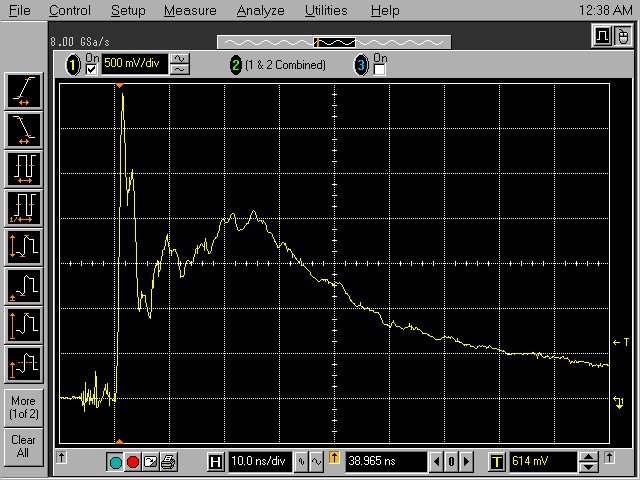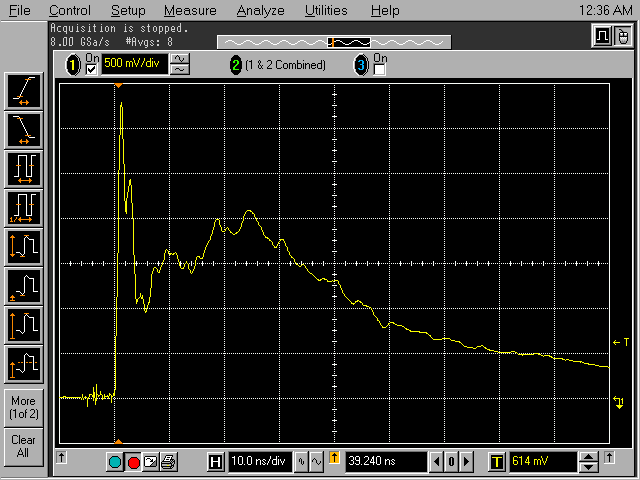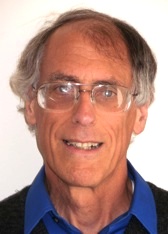
Figure 1. Current Waveform from ESD Simulator
(Vertical = 1/2 Amp/div, Horizontal = 10 ns/div)
Abstract: Noise can
contaminate oscilloscope waveforms for a variety of reasons. ESD
generated noise is among the worst in this respect. The waveform
averaging function in many oscilloscopes can be used to minimize some
types of noise in the waveform, especially ESD generated noise. Use of
averaging for cleaning up scope waveforms is discussed as well as
limitations of the method.
Discussion: Figure 1 shows a waveform of the current from an ESD simulator into a large plane of metal as sensed by a Fischer F-65
current probe. Notice the "hash" that starts about 7 nanoseconds before
the ESD current waveform and gives the waveform a rough appearance for
the first few tens of nanoseconds. In addition, digitizing noise in the
scope also contributes to the slightly rough appearance on the tail of
the ESD generated current. This scope is an older one and newer scopes
are generally better in both respects. But what can one do if noise
contaminates your waveform?
If the contaminating noise is not related to the desired waveform, and if the desired waveform is repeatable, then using a scope's averaging function can substantially clean up the waveform in many cases. This is illustrated in Figure 2 which shows the discharge current of Figure 1 but using an average of eight individual waveforms. The noise on the waveform from both sources is substantially reduced.

Figure 2. Current Waveform from ESD Simulator using Averaging of Eight Waveforms
(Vertical = 1/2 Amp/div, Horizontal = 10 ns/div)
If the contaminating noise is not related to the desired waveform, and if the desired waveform is repeatable, then using a scope's averaging function can substantially clean up the waveform in many cases. This is illustrated in Figure 2 which shows the discharge current of Figure 1 but using an average of eight individual waveforms. The noise on the waveform from both sources is substantially reduced.

Figure 2. Current Waveform from ESD Simulator using Averaging of Eight Waveforms
(Vertical = 1/2 Amp/div, Horizontal = 10 ns/div)
This is a simple technique that I use
often in the lab to cleanup waveforms. Be careful though as averaging
can hide changes in the desired waveform or even cause an inaccurate
display. An example of poor accuracy is a mis-trigger caused
by using a triggering level that is too low. This can result in an
amplitude being displayed that is of lower amplitude than the actual
waveform by contributing a nearly flat trace to the average.
Summary:
With allowances for some limitations, waveform averaging can be used to
cleanup oscilloscope waveforms that are contaminated by noise not
related to the desired signal.
I would like to thank RMV Technology Group at NASA Ames Research Center for use of their facilities to generate the data for this Technical Tidbit.
Additional articles on this website related to this topic are:
- December 2010 Technical Tidbit, Comparing "IEC 61000-4-2 Compliant" ESD Simulators
- November 2010, Comparison of Current Waveforms from 150 Ohm and 330 Ohm Networks in an IEC 61000-4-2 Simulator
- July 2005, Radiated Interference to High Frequency Signal Measurements from the Signal Source
- September 2004, Mobile Phone Response to EMI from Small Metal ESD
(for an example of ESD radiated noise into a scope measurement)
I would like to thank RMV Technology Group for the use of their facilities to perform the tests for this article.
Need help with a design or additional training on technical subjects? Click on the image below to go to CircuitAdvisor.com, a new engineering resource for training, news, and fun.
Need help with a design or additional training on technical subjects? Click on the image below to go to CircuitAdvisor.com, a new engineering resource for training, news, and fun.
If you like the information in this article and others on this website,
much more information is available in my courses. Click here
to see a listing of upcoming courses on design, measurement, and
troubleshooting of chips, circuits, and systems. Click here to see upcoming seminars in Newport Beach, CA.
Click here for a description of my latest seminar titled (now also available online as a WebEx seminar):
EMC
Lab Techniques for Designers
(How to find EMC problems and have some confidence your system will pass EMC testing while it is still in your lab).
(How to find EMC problems and have some confidence your system will pass EMC testing while it is still in your lab).
Home

